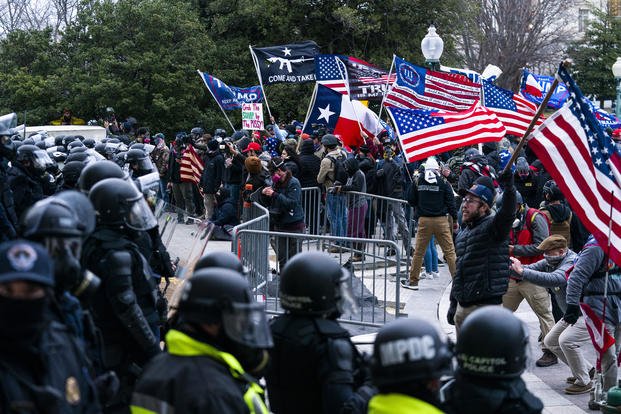Ten members of the Air Force were investigated for trespassing at the U.S. Capitol during the Jan. 6 pro-Trump riot that briefly shut down Congress, according to new extremism statistics released in a Defense Department inspector general report.
Those cases are among 281 investigations into alleged instances of extremism in the military over the first nine months of this year, the watchdog report, released Thursday, shows. It is the first public disclosure of data on the extremist activity and the service branches’ response since the riot. The collection of data was required by annual defense authorization legislation.
The Air Force declined to provide additional information on the 10 trespassing investigations and referred questions to the Justice Department. Some of those cases may have been resolved by the time the IG report was published.
Read Next: There's Petroleum in the Navy's Water System, Hawaii Health Department Finds
The only publicly known charges against an Air Force service member connected to the events of Jan. 6 were filed against 19-year old Aiden Bilyard who was identified by federal officials months after the riot. By that time he was in basic training. According to an Air Force statement, he was separated for erroneous enlistment days after the FBI interviewed him at Lackland Air Force Base. Federal officials arrested him on Nov. 22. It’s not clear if he is among the 10 airmen listed in the report.
The IG collected raw data from each of the services on cases and then categorized them for its report on extremism, which can refer to violent, racist, or anti-democratic causes, groups or social movements. Over the last few years, examples of extremism among troops and veterans have run the gamut from participating in the Jan. 6 riot to offensive social media posts and racist graffiti. It has also been reported in both elite units as well as rank and file formations. There have even been reports of servicemembers trying to recruit others to join groups like the neo-Nazi Atomwaffen Division.
However, the data and the report itself appeared to be incomplete.
Only the Air Force trespassing cases were linked to the Capitol riot by the watchdog report. Yet Military.com has reported that at least five active-duty service members were present on Jan. 6, including one from the Marine Corps and four in the Army and National Guard.
The IG found that data collection across the military is “inconsistent.” Overall, the report notes that while each service has taken action to improve tracking and reporting of extremism, clear direction from the Department of Defense is still needed.
“The military departments reported issues with compiling and validating their data and, in some cases, the reported numbers were conflicting,” the report said. “A clear definition of extremism reflected in the updated DoD Instruction will enable the military departments to identify, track, and report allegations of prohibited activities.”
In all, the IG tallied 294 allegations of extremist activity that led to 281 investigations and 92 instances where some sort of action was taken, including 83 referrals to civilian law enforcement agencies.
The Army, Navy and Marine Corps reported 70 allegations classified by the IG as racially motivated violence. Those services also reported 73 allegations of anti-government extremism.
Meanwhile, most of the Air Force cases -- 102 investigations -- involved allegations of personnel voicing support for extremist causes on social media, Air Force spokeswoman Ann Stefanek said.
“Racism, bigotry, hatred, and discrimination have no place in the Department of the Air Force. We are committed to maintaining a culture where all Airmen and Guardians feel welcome and can thrive,” Stefanek wrote in an email response.
None of the other services reported cases that were included in that category by the IG.
When asked about the discrepancies, a spokeswoman for the IG’s office explained that each branch could define extremism for themselves and that she couldn’t speak for the Air Force classifications or their definitions.
So far the military is without a consistent definition for extremism. Pentagon Press Secretary John Kirby told reporters in late October that the Defense Department’s Countering Extremism Working Group is creating a definition, and its report is "nearing completion.”
Ultimately, the allegations and investigations listed by the IG led to 92 instances where some sort of action was taken, including 83 referrals to civilian law enforcement agencies.
There was one court-martial, 10 non-judicial punishments, 31 administrative actions, and 18 unspecified punishments, according to the data.
But the IG did not identify how specific types of cases had been resolved.
Meanwhile, the absence of clear DoD guidance on what constitutes extremism has left each service working in their own direction, the report found.
The Army requires reporting of extremist behavior to its Criminal Investigation Division while the Marines recently put out an order that provides “options for reporting prohibited activities.” The Navy is developing a tracking system for courts-martial where extremism is involved, while the Air Force modified its case tracking system to add a category for extremism.
This patchwork of reporting mechanisms and repositories of data has created problems. The Marine Corps and the Naval Criminal Investigative Service data did not always align or agree with Navy data, the report said.
The watchdog notes that until a unified policy is set, the military “will continue to have inconsistent tracking of disciplinary actions for participation in extremist organizations and activities; problems identifying and collecting data from multiple, decentralized systems; and difficulty validating the accuracy of the data.”
-- Konstantin Toropin can be reached at konstantin.toropin@military.com. Follow him on Twitter @ktoropin.
-- Travis Tritten can be reached at travis.tritten@military.com. Follow him on Twitter @Travis_Tritten.
Related: What Happened to Members of the Military Accused of Storming the Capitol on January 6?













